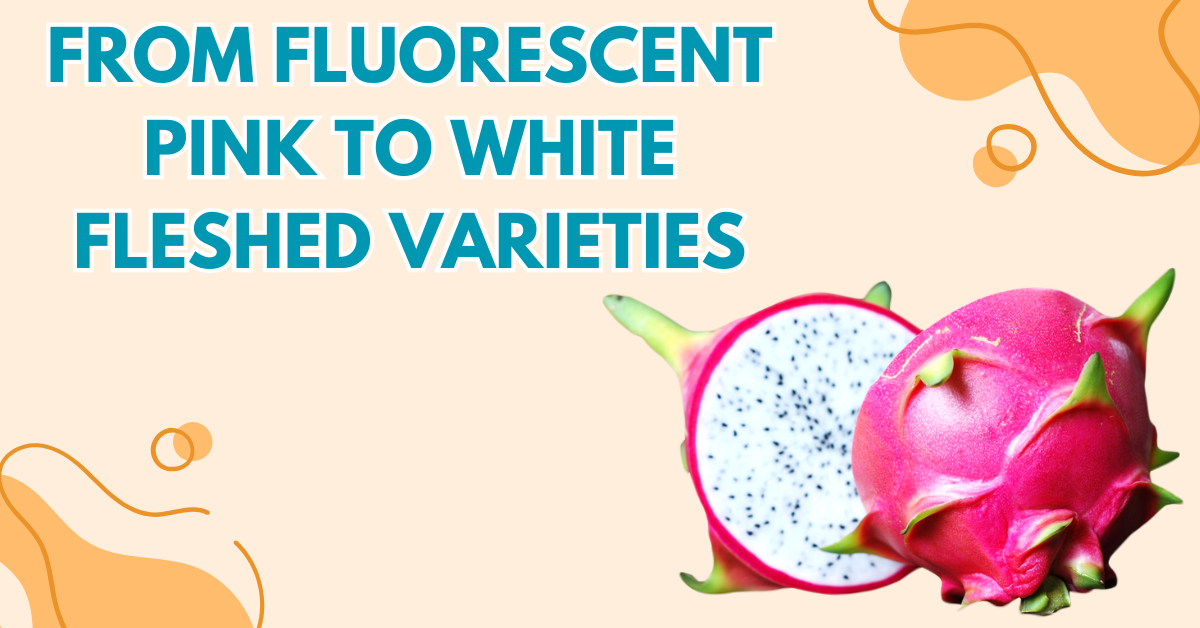When you hear the name “Dragon Fruit”, a vivid mental image often comes to mind — flaming pink skin, spiky green scales, and a speckled interior of black seeds swimming in hot pink or creamy white flesh. But what if we told you that what you’re seeing might not be the real dragon fruit at all?
Yes, this exotic tropical fruit, also called pitaya or pitahaya, is having a full-blown identity crisis. And it’s not just about color — it’s about origin, taste, perception, and marketing deception.
🔍 What Exactly Is Dragon Fruit? A Quick Refresher
Before diving into the color conundrum, let’s rewind a bit. Dragon fruit comes from a cactus — yes, a cactus! — mostly from the genus Hylocereus and Selenicereus. It thrives in warm, dry climates, primarily in Southeast Asia, Central America, and increasingly, India, Australia, and Southern U.S. regions.
There are three main varieties:
| Skin Color | Flesh Color | Taste Profile | Common Name |
|---|---|---|---|
| Pink | White | Mild, refreshing | Hylocereus undatus |
| Pink | Red/Purple (magenta) | Sweet, berry-like | Hylocereus costaricensis |
| Yellow | White | Super sweet, floral | Selenicereus megalanthus |
So where’s the confusion? It begins with looks — but quickly unravels into myths, marketing, and misinformation.
🎨 A Color Explosion or Just Clever Branding?
The fluorescent pink dragon fruit with deep magenta flesh is often marketed as “premium,” “organic,” or “super antioxidant-rich.” You’ve probably seen Instagram influencers slicing into them like edible jewels, glowing with a sci-fi intensity.
But here’s the kicker: that deep magenta flesh isn’t the original dragon fruit. It’s a cultivar — often Hylocereus costaricensis — specially bred and genetically selected for that eye-popping color.
On the other hand, the original, wild-type dragon fruit — Hylocereus undatus — has white flesh, and in many parts of the world, is actually preferred for its milder, crisper taste.
✅ Fact Check: The redder the flesh, the more anthocyanins (antioxidants).
❌ Myth: White-fleshed dragon fruit is “inferior” — in fact, it’s the traditional variety.
📉 Marketing Madness: Are You Paying More for Color?
Absolutely. Thanks to social media and consumer obsession with “superfoods,” the red-fleshed dragon fruit often sells for 30-50% higher prices in many markets.
Here’s a quick price comparison from U.S. & Asia markets:
| Type | Average Price (per kg) | Common Regions |
|---|---|---|
| White-Fleshed Pink | $4 – $6 | Vietnam, Thailand |
| Red-Fleshed Pink | $6 – $9 | Ecuador, Nicaragua |
| Yellow-Fleshed | $8 – $12 | Colombia, Israel |
📈 This price gap is largely driven by appearance and hype — not necessarily nutrition or taste.
🤯 Fun (and Weird) Facts About Dragon Fruit You Didn’t Know
- 🐉 The name “dragon fruit” comes from the scale-like spikes resembling a dragon’s skin.
- 🌙 Dragon fruit flowers bloom only at night — and are pollinated by bats and moths!
- 🍷 The magenta-colored variety can stain your hands and lips like beetroot.
- 🧬 Hybrid varieties like “American Beauty” or “Purple Haze” are crossbred for intense color, not flavor.
- 🔮 Some white-fleshed variants are being modified to be less bland and more citrusy — flavor engineering is real.
🍽️ Taste Test: Which One Wins the Flavor War?
| Category | White Flesh | Red Flesh | Yellow Flesh |
|---|---|---|---|
| Sweetness | ⭐⭐⭐ | ⭐⭐⭐⭐ | ⭐⭐⭐⭐⭐ |
| Texture | Crisp & watery | Creamy & smooth | Juicy, slippery |
| Flavor | Subtle, pear-like | Sweet, hints of berry | Tropical, honey-like |
| Visual Appeal | Neutral | Bold, vibrant | Unusual, exotic |
🎯 Conclusion: If you’re looking for maximum sweetness, go for yellow. For Instagram clout? Pick red. For a refreshing, traditional bite? White’s your friend.
🧠 Why This Identity Crisis Matters (Beyond the Fruit Aisle)
This colorful confusion is more than skin deep. It raises bigger questions:
- 🤔 Do consumers actually know what they’re eating?
- 🌱 Is marketing overshadowing biodiversity?
- 💰 Are we being manipulated into paying more for aesthetics?
Just like other fruits (ever heard of the “Red Delicious” apple flop?), dragon fruit is a lesson in how we value appearance over authenticity — and how food trends shape global agriculture.
🌐 SEO Tip: How To Find The Dragon Fruit That’s Right For You
When buying or writing about dragon fruit online, use these SEO-rich keywords to attract search traffic:
- “Dragon fruit color difference”
- “Red vs white dragon fruit taste”
- “Is white dragon fruit better?”
- “Yellow dragon fruit nutrition”
- “Exotic tropical fruits antioxidants”
- “Dragon fruit benefits by color”
Add long-tail keywords like “Why dragon fruit flesh is different colors” or “Best tasting variety of dragon fruit” to dominate niche search results.
🛒 Pro Tips for Buying the Right Dragon Fruit (Without Being Fooled)
💡 Look for:
- Firm but slightly yielding skin – overripe = mushy.
- Bright color, not faded – fading = old stock.
- No shriveled tips or dry cracks – a sign of dehydration.
- Label transparency – some stores mention the type (red/white/yellow).
🧾 Final Thought: Don’t Judge a Fruit by Its Flesh
Dragon fruit might be facing a colorful identity crisis, but maybe that’s what makes it so beautifully mysterious. Whether you prefer the mild and classic white, the show-stopping red, or the luxurious yellow, one thing is certain:
This fruit is more than a trend — it’s a story. A taste. A tropical symbol. And now, a conversation starter.
📢 Now it’s your turn!
Have you tried all 3 types of dragon fruit? Which one wins for you?
Drop your thoughts in the comments or tag us on Instagram @factsout_official with your favorite #DragonFruitCrush 🍓🐉



